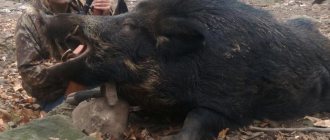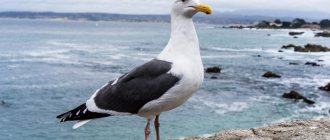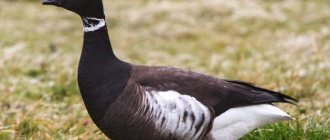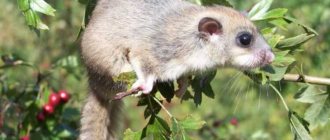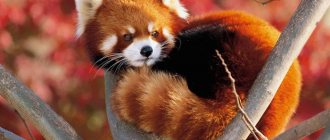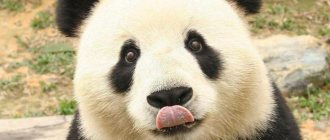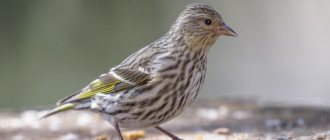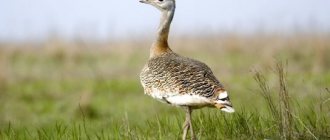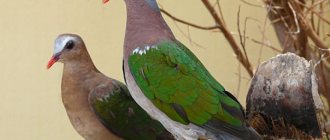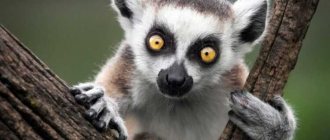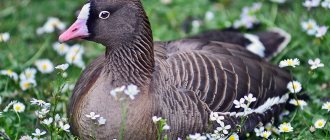- Wild animals
- >>
- Birds
The red-breasted goose is a small, slender waterfowl belonging to the duck family. Externally, the bird is very similar to a small goose. The bird has a very bright color, the chest and the lower part of the bird's head are brown-red, the wings, abdomen and tail are contrasting black and white. It is quite difficult to meet this bird in the wild, since the species is very rare and there are extremely few birds left in nature. They usually nest in the tundra.
Origin of the species and description
Photo: Red-breasted goose
Branta ruficollis (Red-breasted Goose) is a bird belonging to the order Anseriformes, family Anatidae, genus Goose. The order of Anseriformes, which includes geese, is very ancient. The first Anseriformes inhabited the earth at the end of the Cretaceous period or at the beginning of the Paleocene of the Cenozoic era.
The earliest fossils found in America, New Jersey, are about 50 million years old. The ancient bird's belonging to the order Anseriformes was determined by the condition of the bird's wing. The spread of anseriformes around the world supposedly began from one continent in the Southern Hemisphere of the earth; over time, the birds began to explore more and more new territories. The species Branta ruficollis was first described by the German naturalist Peter Simon Pallas in 1769.
Video: Red-breasted Goose
The main features of the bird include its bright color and rather short beak. Geese are small birds with a slender body. The feathers on the head and chest of the bird are bright red-brown. The back, wings and tail are black and white. The bird's head is small; unlike other geese, red-breasted geese have a large, thick neck and a very short beak. In size, the goose of this species is slightly smaller than the brant goose, but larger than the goose of other species. Red-breasted geese are flocking migratory birds; they are very hardy and capable of flying long distances.
Appearance and features
Photo: What does a red-breasted goose look like?
Birds of this species are almost impossible to confuse with other waterfowl due to their unusual color. The bird received the name “Red-throated” because of the bright brown-red plumage on the neck, chest and cheeks. On the top of the head, back, and wings the plumage is black. There are white stripes on the sides, head and undertail. There is a bright white spot near the bird's beak. Males and females have similar colors and externally it is difficult to distinguish a male from a female. Juveniles are colored the same way. like adult birds, but the color is duller. There is no feathering on the limbs. The beak is black or dark brown short. The eyes are small, the iris is brown.
Geese of this species are small birds; the body length from head to tail is 52-57 cm, the wingspan is about 115-127 cm. The weight of an adult is 1.4-1.6 kg. Birds fly quickly and well and have a nimble, restless character. During the flight, the flock can make unexpected turns, the birds can gather and, as it were, press together, forming a kind of ball in the air, then scatter again in different directions. Geese are excellent swimmers and can dive. When lowered into the water they make a loud cackle. They are very sociable and constantly communicate with each other.
Vocalization. Geese of this species produce two-syllable loud cackles, sometimes similar to clucking. Most often, sounds similar to the sound “gvyy, givyy” are heard. When the bird senses danger, the goose can hiss loudly in order to scare its opponent.
Interesting fact: Red-breasted geese are truly long-lived among birds; under good conditions, birds can live about 40 years.
Where does the red-breasted goose live?
Photo: Red-breasted goose in Russia
The habitat of red-breasted geese is quite limited. Birds live in the tundra from Yamal to Khatanga Bay and the Popigai River valley. The main part of the population nests on the Taimyr Peninsula and inhabits the Upper Taimyr and Pyasana rivers. These birds can also be found on a small section of the Yuribey River not far from Lake Yaroto.
Like all migratory birds, red-breasted geese go to warmer regions for the winter. Birds like to winter on the western shores of the Black Sea and the Danube. The birds fly away for the winter at the end of September. Ornithologists have even studied the migration route of these birds. During migration, birds fly over the Ural ridge in the valleys of the nearest rivers, then the birds, reaching Kazakhstan, make a turn to the west, there, flying over the steppe and wastelands, the Caspian lowland, they fly over Ukraine and remain to winter on the shores of the Black Sea and the Danube.
During migration, birds make stops to rest and gain strength. The flock makes its main stops near the Arctic Circle at the Ob spill sites, in the north of Khanty-Mansiysk, in the steppe and wastelands of Tobol in the valleys of the Manych River, in Rostov and Stavropol. During the nesting period, birds settle in the tundra, forest-tundra and wastelands. For life, they choose flat areas located near a reservoir; they can settle on cliffs and ravines near rivers.
Now you know where the red-breasted goose is found. Let's see what this bird eats.
Behavior
The goose itself is a very active and energetic bird; it is very sociable and easily gets used to different situations. During the flight, the goose looks more like a red duck than a goose. When birds stop, their fussiness and rapid movement from place to place are often noted, because if it were an ordinary goose, it would behave more calmly.
Goose of any age is an excellent swimmer and diver. As it descends onto the water, it makes a lot of sounds: a quiet and hoarse cackle, a scream. This is how the birds communicate with each other and let them know that everything is fine with them. They are also capable of producing sounds reminiscent of the hissing of a snake.
To create nests, geese prefer bushes and lichens in the tundra. They also love hills, proximity to water, birch trees, and weeds. They often nest on the banks of rivers with steep slopes; less often they can be found on rocks.
What does the red-breasted goose eat?
Photo: Red-breasted goose bird
Geese are herbivorous birds and feed exclusively on plant matter.
The diet of red-breasted geese includes:
- leaves and shoots of plants;
- moss;
- lichens;
- cotton grass;
- sedge;
- horsetail;
- berries;
- bedstraw seeds;
- wild garlic bulbs and leaves;
- rye;
- oats;
- wheat;
- barley;
- corn.
In nesting areas, birds feed mainly on leaves and rhizomes of plants that grow in nesting areas. These are mainly sedge, horsetail, and narrow-leaved cotton grass. It must be said that the diet is rather meager, because in the steppe you will not find many different herbs. Birds peck at the berries they come across.
In winter, birds usually live on lawns and pastures, fields sown with winter grain crops. At the same time, birds peck grains, young leaves and roots of plants. Birds eat mainly during the wintering period; on wintering grounds, the diet of birds is much more varied than in nesting areas. During migrations, birds feed on plants that grow in the places where they stop, mainly sedge, clover, lungwort, horsetail and many other types of plants. Chicks and juveniles feed on soft grass, leaves and seeds of plants, while the chicks, hiding from predators together, live with their parents in thickets of grass until they learn to fly.
Nutrition
Since the bird is a waterfowl, diving catches small crustaceans, aquatic larvae and insects. It dives, immersing half of its body in the water, leaving only its tail on the surface. For example, brent geese can dive to get food to a depth of 50 to almost 80 centimeters. Often picks up mud while in flight.
On land during the spring-summer seasons, they eat many plants: clover, angustifolia cotton grass, bluegrass and other herbs that grow in the lowlands near water bodies. During reproduction, they eat rhizomes and shoots of herbs. If there is a lack of green vegetation, they begin to eat plant seeds and wild garlic bulbs.
With a forced change of habitat, during flight to more favorable areas, the diet of birds changes. During migration, they feed on algae and insects on mudflats.
If there are crop meadows nearby, birds look for food in the fields after the harvest. They eat crop residues: oats, millet, rye. During the wintering period, the red goose nests near the areas of winter crops. Therefore, in addition to harvest residues, if fields with winter crops are found, it feeds on winter crops.
Features of character and lifestyle
Photo: Red-breasted goose from the Red Book
Geese of this species are typical migratory birds. The birds winter on the shores of the Black Sea and on the Danube. Mostly in Bulgaria and Romania. The birds fly away for the winter in late September, and in the spring they return to their nesting sites in early June. Unlike geese and other birds, geese do not fly in large flocks during migration, but move in colonies of 5 to 20 pairs. Birds fly to the nesting site in pairs formed during the winter. Red-breasted geese love to settle on the steep banks of reservoirs, in the steppe, forest-steppe, and valleys near rivers. Upon arrival, the birds immediately begin to build nests.
Interesting fact: Geese are quite intelligent birds; they build their nests next to the nests of large birds of prey such as the peregrine falcon, snowy owl or buzzards.
Birds of prey protect their nest from various mammalian predators (arctic foxes, foxes, wolves and others), while the geese's nest also remains out of reach of enemies. Such a neighborhood is the only way to raise chicks. Even when settling on steep and dangerous slopes, the geese's nests are always under threat, so the birds try not to take risks and find a good neighbor.
Geese are active during the daytime. At night, birds rest on the water or in nests. Birds obtain food for themselves near the nest, or near a reservoir. In a flock, birds are very sociable. The social structure is developed, birds live in pairs at the nesting site, and gather in small flocks during the winter. Conflicts usually do not arise between birds.
Birds treat humans very carefully; when a person tries to approach the nest, the female lets him in and then tries to fly away unnoticed. At the same time, the male joins her, the pair flies around the nest, and makes loud sounds trying to drive away the person. Sometimes geese find out about the approach of a predator or a person in advance; the predator-protector notifies them about this. In recent years, when the population began to be in danger of extinction, these birds began to be kept and bred in various nurseries and zoos. In captivity, the birds feel good and reproduce successfully.
Literature
- Boehme R. L., Flint V. E.
Five-language dictionary of animal names. Birds. Latin, Russian, English, German, French / Under general. ed. acad. V. E. Sokolova. - M.: Rus. lang., "RUSSO", 1994. - 845 p. — 2030 copies. — ISBN 5-200-00643-0. - Boehme, R. L.;
Kuznetsov, A. A. Birds of open and near-water spaces of the USSR. - M.: Education, 1983. - 176 p. - Vinokurov, A. A.
Rare and endangered animals: Birds. - M.: Higher School, 1992. - 446 p. — ISBN 5-06-002116-5. - Dementyev, G. P.;
Gladkov, N. A. Birds of the Soviet Union. - Soviet Science, 1952. - T. 4. - 647 p. - Linkov A. B.
Red-breasted goose on the rivers Yesyakha and Gyda (Gydan) // Birds of Siberia: Abstract report for the II Siberian Ornithological Conference. - Gorno-Altaisk, 1983. - P. 83-84. - Ma, Y.
Birds from the Red Book of the RSFSR in China. // Rare and needing protection animals. Materials for the Red Book. - M.: Collection of scientific works of the Central Scientific Research Laboratory of Glavokhoty of the RSFSR, 1989. - 175 p. - Koblik E. A.
Diversity of birds (based on the materials of the exhibition of the Zoological Museum of Moscow State University. - Moscow State University Publishing House, 2001. - Vol. 3 (Orders Owl-formes, Nightjars, Swifts, Mousebirds, Trogoniformes, Coraciiformes, Woodpeckers, Passeriformes (family. Poison dart frog-Mockingbirds) - 358 pp. - ISBN 5-211-04072-4. - Rogacheva E. V.
Birds of Central Siberia. Distribution, abundance, zoogeography. - M.: Nauka, 1988. - 310 p. — ISBN 5-02-005252-3. - Ryabitsev V.K.
Birds of the tundra. - Sverdlovsk: Central Ural Book Publishing House, 1986. - 192 p. - Ryabitsev V.K.
Birds of the Urals, the Urals and Western Siberia: A reference guide. - Ekaterinburg: Ural University Publishing House, 2001. - 608 p. — ISBN 5-7525-0825-8. - Syroechkovsky E. E., Rogacheva E. V.
Fauna of the Krasnoyarsk Territory. - Krasnoyarsk: Krasnoyarsk Book Publishing House, 1980. - 360 p. - Stepanyan, L. S.
Abstract of the ornithological fauna of Russia and adjacent territories. - M.: Akademkniga, 2003. - 808 p. — ISBN 5-94628-093-7. - Carboneras, C. 1992. Family Anatidae (Ducks, Geese and Swans) in del Hoyo, J., Elliott, A., & Sargatal, J., eds.
Vol. 1. // Handbook of the birds of the world. - Barcelona: Lynx Editions, 1992. - ISBN 84-96553-42-6. - Johnsgard, Paul A.
Ducks, Geese, and Swans of the World. Revised Edition. — University of Nebraska, 2010. — 404 p. — ISBN 0803209533. - Kear, Janet.
Ducks, Geese and Swans. - Oxford: Oxford University Press, 2005. - 930 p. — ISBN 0198546459. - Scott, Derek A.;
Rose, Paul M. Atlas of Anatidae populations in Africa and Western Eurasia. - Wetlands International, 1996. - 336 p. — ISBN 1-900442-09-4. (English)
Social structure and reproduction
Photo: Pair of red-breasted geese
Red-breasted geese reach sexual maturity at 3-4 years of age. Birds fly to nesting sites in previously formed pairs, and upon arrival at the nesting site they immediately begin to build nests. The nest is built in a depression in the slope, filled with stems of cereal crops and lined with a layer of down. The size of the nest is about 20 cm in diameter, the depth of the nest is up to 8 cm.
Before mating, birds have quite interesting mating games; the birds swim in a circle, plunge their beaks together into the water, and make various sounds. Before mating, the male takes a vertical position with his wings spread and overtakes the female. After mating, the birds fluff their tails, spread their wings to the sides and stretch out their long powerful necks, while bursting into their strange song.
After some time, the female lays 4 to 9 milky-white eggs. Incubation of eggs lasts about 25 days, the eggs are incubated by the female, while the male is always nearby, protects the family and brings food to the female. The chicks are born at the end of June; by the time the chicks appear, the parents begin postnuptial molting, and the parents lose the ability to fly for some time, so the entire family lives on lawns, trying to hide in dense thickets of grass.
Often broods from different parents unite together, forming a large, loudly squeaking flock guarded by adult birds. At the end of August, the juveniles begin to fly a little, and at the end of September, the juveniles, together with other birds, fly away for the winter.
Number
The world population of the species, estimated in 1989, exceeds 35,000 individuals. In the Krasnodar Territory, during migrations, the red-breasted goose is not numerous and does not form concentrations. In the 1970s, up to 100 adult individuals were recorded in flocks of migratory birds. About 400–500 individuals were recorded in the Eastern Azov region.
In Bulgaria and Romania, where most red-breasted geese winter, about 75,000 individuals were counted in the winter of 1992-93. In the floodplain of the Moksha River in Mordovia, in the spring of 1996, hundreds of representatives of the species were observed.
In 1977, 3,000 individuals lived on Yamal, 4,500 on Gydan, and about 20,000 on Taimyr. In 1989, the total population exceeded 35,000 individuals, most of which lived on the Taimyr Peninsula, mainly in the basins of the Pyasina and Upper Taimyr rivers.
On Yamal in favorable years the number of geese reaches 2,500 - 4,000, on Gydan 6,000 - 8,500 individuals.
Limiting factors include:
- shooting birds during sport hunting;
- economic development of shallow waters in the floodplain zone;
- reduction in the areas of coastal lowlands in wintering areas;
- the use of poisoned grain in the fight against rodents and pests.
Natural enemies of red-breasted geese
Photo: Red-breasted goose on the water
Red-breasted geese have quite a lot of enemies in the wild, and without the protection of stronger birds of prey, it is very difficult for these anseriformes to survive.
The natural enemies of these birds are:
- arctic foxes;
- foxes;
- dogs;
- wolves;
- hawks;
- eagles and other predators.
Geese are very small birds, and it is quite difficult for them to protect themselves. Even if adult birds can run and fly quickly, juveniles cannot defend themselves. In addition, adult birds during molting become very vulnerable, losing the ability to fly. Therefore, during the nesting period, birds try to always be under the protection of a large feathered predator, which, while protecting its own nest, also protects the brood of geese.
Interesting fact: Because of their bright plumage, birds cannot hide well; often a nest with a female sitting on it is visible from afar, but not everything is so simple. Birds are often warned of danger long before the enemy appears, and can manage to fly away and take their cubs to a safe place.
However, the main enemy of the geese is still man and his activities. Despite the fact that hunting for this species of geese is prohibited, no one takes into account how many individuals are killed by poachers per year. Previously, when hunting for these birds was allowed, the geese were almost completely exterminated by hunting them. Another negative factor was the development of bird nesting sites by humans. Extraction in oil and gas nesting areas, construction of factories and structures.
The story of life at the Moscow Zoo
Red-breasted geese first bred in the Moscow Zoo back in 1958–59. After this, extensive work on studying and breeding these birds in captivity at the zoo resumed in 1983, when a large group of red-breasted geese arrived here, caught in the wild on the Taimyr Peninsula. It turned out that the desires of the employees and the birds themselves regarding nesting on the ponds of the Moscow Zoo did not coincide sharply. The geese categorically did not want to become parents. One of the obvious reasons for this was the incorrect ratio of males and females in the group: there were almost twice as many males. This skewed ratio dramatically altered the birds' normal nesting behavior.
A thorough study of the life of red-breasted geese in nature (a scientific expedition to Yamal was organized) and literary data made it possible to identify the main reasons why red-breasted geese could not breed in the zoo. The main ones were: 1) the discrepancy between the food ration in captivity and in nature (in nature - plant species rich in plant protein); 2) inconsistency in temperature conditions (as paradoxical as it may sound, the polar species suffered from Moscow frosts). A change in diet and a significant artificial increase in daylight hours to 18 hours finally gave a positive result - in 1987, the long-awaited offspring of red-breasted geese were obtained. By 1998, the Moscow Zoo had received 20 red-breasted geese chicks.
Currently, the breeding of red-breasted geese in captivity is so well established that they are no longer caught in the wild for zoos. The Red-breasted Goose can be seen in the pergola on the Old Zoo grounds. Our ornithologists are planning to soon increase the group of these beautiful birds.
Population and species status
Photo: What does a red-breasted goose look like?
Red-breasted geese are very rare birds. The species Branta ruficollis has the conservation status of a vulnerable species, a species on the verge of extinction. Today, this species is listed in the Red Book of Russia, and birds of this species are protected. Trapping and hunting of birds is prohibited throughout the world. In addition to the Red Book, this species is included in the Annex to the Bonn Convention and Annex 2 to the CIETES Convention, which guarantees a ban on trade in this bird species. All these measures were taken due to the fact that from the end of 1950 to 1975, the population of the species sharply decreased by almost 40% and from 50 thousand adult birds only 22-28 thousand adult birds remained.
Over time, with the use of environmental measures, the population of the species grew to 37 thousand adult individuals. However, this figure is also quite low. There is no place for birds to breed. Due to the arrival of humans in the natural habitats of birds and climate change, nesting sites are becoming less and less. Scientists say that due to global warming, the area of the tundra is rapidly decreasing. The population of the species is also significantly influenced by the number of Samson falcons. Birds settle next to them and come under their protection; with a decrease in the number of these predators, it becomes more and more difficult for geese to survive in the wild and this also negatively affects the population.
Today, geese of this species are protected and various protective measures are taken against them. Some nesting sites are located in protected areas and reserves. Catching birds for zoos, hunting and selling birds throughout our country is prohibited. The birds are bred in nurseries, where they successfully breed and are later released into the wild.
